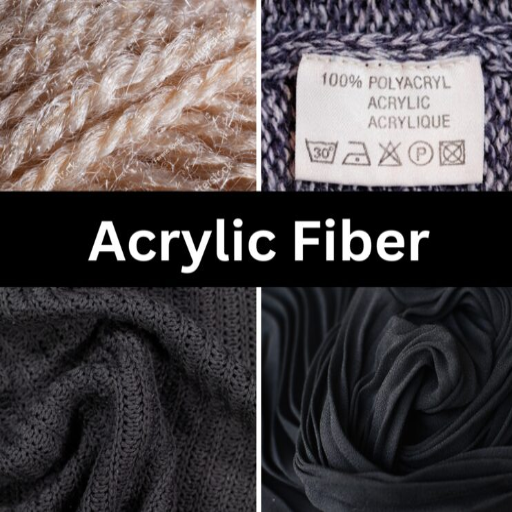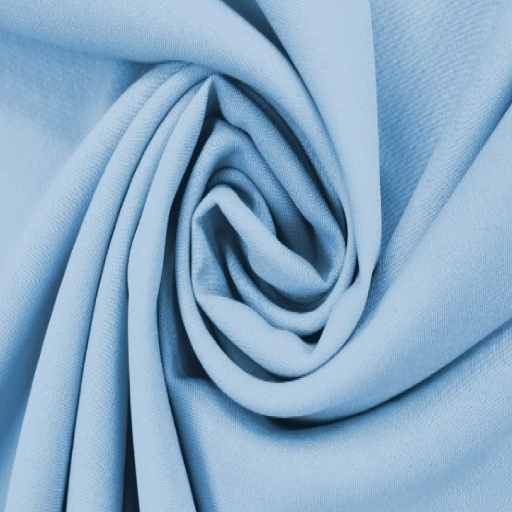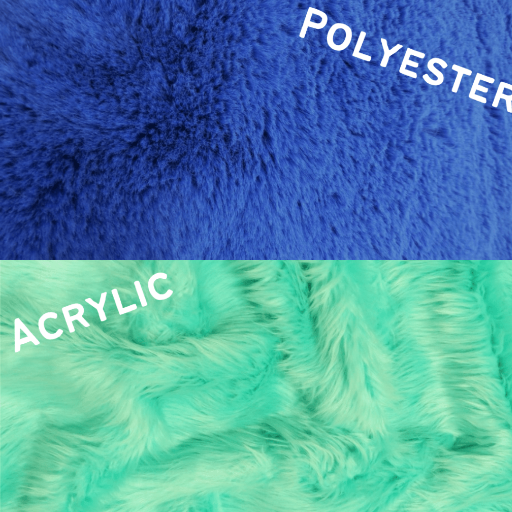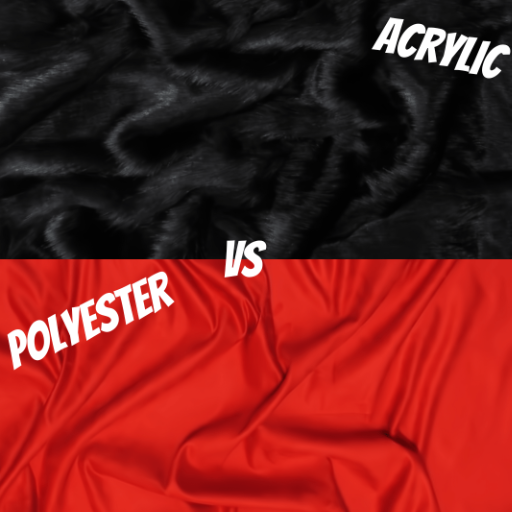Acrylic vs Polyester: A Comprehensive Comparison
With the advancement of man-made fibers, it is essential to handle their selection with utmost care, as the options available may actually surprise you. Today, people are most accustomed to acrylic and polyester, as these two materials are synthetic and have been widely accepted into society, with numerous applications. But what is the difference between these two kinds of fabrics, as supposedly they are the same? Which one is more suitable for a particular use? This article provides a comprehensive comparison of acrylic vs. polyester, focusing on which material is better in terms of quality and practicality. By the conclusion of the text, you will be able to identify the benefits and drawbacks of each fabric, helping you focus on whatever project or purchase. Get ready to drop the old and get the new updated materials, as we find somewhere in between these materials the differences and yet at the same time the similarities. Click here to read more.
What is Acrylic?

Acrylic is a man-made thread that is made from clothing or is made from pre-existing clothing made from weaving. This is too superficial and too straightforward, which is why it is beneficial for fashion applications beyond its core purpose. It is also where it is used in quantity to prepare lame and hosiery. Although it has several advantages, it may also have disadvantages if the hypocritical practices involved are carried out. Furniture is the primary carrier of this type of furniture, and the acrylics are often mixed with certain other materials to make it last longer. Such adjectives are used when referring to children’s clothes, as children are warmer during autumn than at other times. Children’s clothes are great when bought in a pack. Whether it’s a bed, a pillow, or a couch, almost all the items in one’s shelter will have one component in them – acrylic.
Definition and Characteristics of Acrylic
Acrylic fiber offers a wide range of applications across various fields due to its versatile and adaptable properties. Specifically, the fashion industry extensively relies on this material in the process of making elements such as knitted jumpers, mittens, tights, and many other things like that because the wool-like texture helps them retain heat effectively. Similarly, acrylic is used in the field of home decorations, including soft floor covers, seat covers, and wall hangings, simply due to damage resistance and minimum maintenance requirements. As for textiles, it is not surprising to see acrylic being used in the fabrication process of outdoor wear, weatherproof clothing, and the like. Moreover, the possibility of using acrylic and the effectiveness of the material are largely cost-oriented.
Common Uses of Acrylic
Acrylic, which exhibits adaptable malleability, is extensively used across different industries. It is used in the fashion industry, interiors, and extends to construction, signboards, and car production. It is clear as water and very often used in sheets for producing these cuts for vibrant windows, separating panels, colorful aquariums, and stained glass, for instance. These products exhibit excellent optical and mechanical properties – transparency, break resistance, and low mass. Therefore, it can be asserted that acrylics are a major player in the field of sign-making due to their resilience and ease of moulding or laser etching, which enables the production of unique and enduring signs. Moreover, polymethyl methacrylate is valued in the automotive industry for the production of headlight covers and some decorative parts. Thanks to the acquisition of long-term durability, in the field of construction, abstraction economically means emptying the entire inventory on site, since the building is not needed after the conclusion of operations in this. Because it would be wasteful to use such luxurious building materials for a one-off or just a “one-off” construction work, no example of such available buildings exists, not even in ancient or modern history.
Key Properties of Acrylic
Polymethyl methacrylate, commonly known as PMMA and also referred to as acrylic in generic terms, is a flexible thermoplastic with specific physical and mechanical properties, which make it useful for various purposes. It is nearly transparent to the extent that it allows around 92% of light to pass through it. This provides saturation comparable to that of glass. In addition, it exhibits excellent resistance to harsh weather conditions, making it suitable not only for indoor use but also for outdoor use. Owing to the fact that acrylic is lightweight which is almost 50% less than the weight of the same quantity of glass, an additional factor that makes it a more preferable option is its higher resistance to mechanical damages.
Furthermore, its application is facilitated because of its high melting point and it can easily be molded, cut, or sculpted. Hence, it is a material essential to the construction, automobile, and design industries, among others. With these critical characteristics, it is clear why Acrylics are the first choice for both very creative and authentic designs.
What is Polyester?

Any person who spends a considerable amount of time on regular shopping and concludes with a busy shopping spree for women’s fashion accessories still finds luxury men’s watches to be more significant and a perfect present they can offer. Japan is a leader in the wristwatch industry and innovation, thanks to companies such as Seiko, Orient, Citizen, and Casio. The total production of watches and clocks from factories worldwide reached a volume of 783.4 million pieces, with 101.6 million of these being Swiss watches, in 2016. Two watch manufacturing and business locations have been identified in two separate geographical areas in modern Japan: one is Kansai and the other is Shizuoka, indicating the successful configuration of two possible business plans – establishing wholesale at the factory and plant levels from which watches are produced and sold to the market.
Definition and Characteristics of Polyester
Although it is easy to appreciate the usability and level of sturdiness the material provides, an essential component is the realisation of the embedded environmental compatibility of polyester. The material is produced from oil, a source that cannot be replaced, yet it is subjected to a rather severe production system. Furthermore, even in terms of texture, polyester is one of those materials that do not decompose naturally. This is the reason why the material may persist in the environment for up to a few hundred years, causing surface water and aquatic systems to become infested with microplastics. On the positive side, gathered recyclable technologies from recent days and the demand for eco-friendly products, a new type of fiber called t/p became a feasible reality. Genuine polyester produced from waste eliminates a larger volume of virgin petroleum per fiber, yet such polyester does not present larger quantities of free plastic. Innovatively utilized manufacturing practices and waste recovery are necessary to enhance the sustainability of polyester.
Common Uses of Polyester
Polyester fabric holds a prominent place among synthetic fibers due to its versatility and exceptional ability to be used in numerous sectors of the economy. This type of fabric is versatile and suitable for various uses, such as clothing production, because it withstands wear and tear, remains rigid, and retains its class. When it comes to clothing design, a significant percentage of sports outfits and clothing for planned physical activities incorporates polyester due to the fabric’s characteristics of moisture wicking and rapid water absorption. This kind of textile is used not only in clothing but also in the decor and furnishing of homes, thus can in fact be seen on curtains, for example. Moreover, it offers excellent potential for manufacturers of consumer products, as among other things, polyester is found in various industrial items such as basket lifters, straps, and car tires. Maximum flexibility and low cost have ensured that it is a regular component of everyday goods as well as some high-tech products.
Key Properties of Polyester
- Durability: Polyester is a durable and resilient material that is resistant to cracking, shrinking, and wear. It guarantees that polyester products retain their shape even after prolonged use.
- Moisture Resistance: Polyester is also remarkable for its poor absorption performance of water, which is easily dismissed. It is these qualities that make it particularly suitable for fabrics that require moisture absorption or applications where quick suspension is needed.
- Wrinkle and Shrinkage Resistance: Due to the structure of the fibers, polyester fabric does not require a deep press and wrinkles easily, which is why it is especially popular for ready-to-wear clothing and knitwear.
- Lightweight and Versatile: Although polyester is incredibly durable and abrasion-resistant, it remains lightweight and can be utilized in various applications, from clothing to automotive parts.
- Thermal Insulation: Polyester also possesses thermal insulating properties, which makes it suitable for cold weather clothing like jackets and sleeping bags – that is what this statement means.
Polyester, a synthetic fiber material, is tough and durable, shows excellent chemical and stain resistance properties, and can resist many acids and alkali chemicals, solvents, and oils. Additionally, polyester carpets are more resistant to various kinds of staining than natural carpets. As a result, it is considered easier to maintain it, and who wore it last is known for its really easy-to-clean synthetic.
Acrylic vs Polyester in Specific Applications

In the application aspect, Acrylic has good thermal insulation properties, resists ultraviolet rays, and is applicable over a wide temperature range, while polyester has better resistance to wear and tear and wicks away moisture more effectively. It is mainly used by individuals who wish to utilize it for multiple purposes.
|
Application |
Acrylic |
Polyester |
|---|---|---|
|
Clothing |
Warm, Soft |
Durable, Breathable |
|
Activewear |
Moderate Wicking |
High Wicking |
|
Socks |
Warm, Cushioned |
Durable, Lightweight |
|
Upholstery |
UV Resistant |
Abrasion Resistant |
|
Outdoor Use |
UV Protection |
Weatherproof |
|
Marine Fabric |
Colorfast |
Strong, Durable |
|
Home Textiles |
Soft, Warm |
Easy Care |
|
Cost |
Affordable |
Moderate |
Comparative Analysis in Clothing
Acrylic material in daily dressing aids in warmth and softness, while polyester tends to be strong, breathable and able to wick out moisture.
|
Key Point |
Acrylic |
Polyester |
|---|---|---|
|
Texture |
Soft, Wool-like |
Smooth, Synthetic |
|
Warmth |
High |
Moderate |
|
Durability |
Moderate |
High |
|
Breathability |
Low |
High |
|
Moisture |
Moderate Wicking |
High Wicking |
|
Weight |
Lightweight |
Lightweight |
|
Care |
Hand Wash |
Easy Care |
|
Cost |
Affordable |
Moderate |
Marine Fabrics: Performance and Protection
Concerning marine textiles, acrylic and polyester have their unique qualities that make them advantageous over the other, but this will mainly depend on the needs of the person. Acrylic textile is primarily considered as they are good in UV exposure, thus making them ideal for regions that receive a lot of sun, such as those in need of boat covers or awnings. The colors do not fade, and their appearance is retained over long periods due to their vibrancy. Additionally, the resistance to fading ensures they remain appealing for quite some time. In addition to effectively avoiding the growth of mold, acrylic is also found to be effective because it is not susceptible to dampness in marine surroundings.
At the opposite end of the stick are the overly durable and strong polyester fabrics. These textiles can stretch and tear; they are extremely resistant to wind and water pressure. This is because polyester has greater abrasion resistance, making it more preferable in applications such as sailcloths or protective engine covers. The reason is that some contemporary polyester fabrics used in boats or yachts are treated with waterproofing agents to prevent water leaks through the fabric, especially laminated or coated fabrics.
In conclusion, the question is settled on a case-by-case basis, as it depends on the specific requirements in a particular situation, such as the intensity of ultraviolet rays, the likelihood of corrosion, or the possibility of getting wet, at the very least. The design features ensure the best behavior.
Socks and Activewear: Durability and Comfort
For all occasions, the user might require attire such as socks and sports equipment. This means that you should look for products that are both strong and breathable. Technological advancements have encouraged the production of fabrics that place greater emphasis on enduring fabric scores. These materials are durable due to their gentle and breathable design, such as merino wool, high-performance fabrics made from polyester-based products, and many other fabrics. The antitoss is also fascinated by the nearness of the features in advanced products. Overcut does not create lines on the region that impinges upon the freedom of limb. This is achieved through the optimal material composition and suitable pattern solutions in garment construction. Socks and sports attire, which are designed to give all the mentioned benefits, lead to greater performance and higher content, having been improved.
How to Choose Between Acrylic and Polyester

When it comes to choosing between acrylic and polyester, your particular requirements and inclinations will suffice. The former is tender, warm, and weightless, which on the whole underscores its suitability for frigid temperatures or insulation-oriented ventures. Conversely, polyester has greater sturdiness, is naturally anti-sweat, and does not fold easily; it is, therefore, better suited for working clothes and outdoor enthusiasts. In conclusion, if you prioritize the paramount aspect of personal comfort and warmth, it is a model to consider using acrylic. On the other hand, when you need sturdiness and working features, the polyester choice is more serviceable.
Factors to Consider in Your Choice
When choosing between acrylic and polyester, several factors should be considered to ensure you select the right material for your needs. In this discussion, there are five vital ones that are given consideration:
- The Physical and Esthetic Factors
Acrylic is more comfortable than polyester in terms of the stickiness and the warmth of the fabrics, especially on colder days. It is not easily wrinkled, so it does not require such intricate care when wearing it. As for the Polyester, it has a multidirectional stretch mainly because it is fairly smooth even on the outside.
- The Strengths and Weaknesses of the Materials
Polyester has high inherent strength and, as such, is well-suited to conditions of wear and tear over a longer period. Acrylic does not withstand much use and is likely to pill with repeated use. Additionally, after washing, the garment tends to have a mangy look.
- Absorption and Drying of Water
One of the properties of polyester is that it is very good at absorbing a large amount of water and drying quickly, making it suitable for athletics or outdoor activities. However, the same cannot be said of acrylic, as it does not wick moisture at all.
- The Value of Different Thicknesses and Weights
Acrylic is a material that can be described as lightweight, while also providing a high level of thermal resistance. For those with more severe weather conditions, it is particularly effective. Polyester is also a lightweight material, although it may not provide the same warmth as acrylic, as it does not replicate the warmth effect of acrylic.
- Taking Care Of The Materials
Polyester fabrics are designed to wrinkle less and are easy to clean, as washing usually does not affect their shape. You should still be mindful of acrylic fabrics, as they can become rough in texture early in their use.
Tips for Selecting the Right Material
- Geographical Restrictions, Compatibility, and Needs
The primary purpose of the materials and the environment being compatible with each other is a key point that needs to be addressed. For instance, acrylic, due to its properties, is most often used in frigid climates because of its ability to insulate against heat, while polyester can be more comfortable in tropical or muggy climates.
- Estimate Life Expectancy
Polyester is more practical and has a longer life expectancy than cotton, as it resists wrinkles and creases much more evenly with frequent use and washing. Unlike cotton, polyester is not as soft and warm, so it may be advisable to wear it less often, as it might start pilling.
- Check Maintainability
Try to identify the extent to which you are responsible for the care and maintenance of the property. Because the former is usually machine-washable, polyester requires low maintenance, especially given the fact that current lifestyles are very fast-paced. Conversely, it is challenging with acrylic, as you are likely to appreciate its good aspects only when you put them at risk.
- Establish Economic Justification
Analyze the expense and the profit from investing in a particular fabric. Economically efficient and readily available, polyester caters to financially conscious consumers. Acryl also caters to their specialty needs, even though it might be more expensive.
- Ease of use first!
When it comes to the products that will be worn closest to the skin, it will be crucial to make sure that the primary principle of comfort is rendered: Proper accoutrements are made using acryl as it is more malleable and better at maintaining warmth making it possible for snug fittings to be achieved, polyester, on the other hand, is more rigid and lighter making it better for use during physical activities”.
Frequently Asked Questions (FAQs)
What Are the Differences between Acrylic and Polyester?
The key differences between acrylic and polyester are their fabric properties and the mechanisms of the polymer. While polyester fabric is a fiber made from petroleum, acrylic, on the other hand, is a man-made fiber manufactured from polyacrylonitrile. Acrylics are generally softer and more insulating, which is why people choose it for sweaters and as blankets. Polyester, on the other hand, is rugged and dries sweat pretty quickly, which is why it is suitable for sports equipment wear.
Is It Better to Wear Acrylic or Polyester?
The superiority of acrylic or polyester material is primarily determined by personal choice and the intended use of the clothing in question. Acrylic is more flexible and helps increase warmth by acting as an insulator in cold climates. In contrast, polyester is, while stiffer, more resistant to piling and much better at managing moisture, which explains why it is preferred for activewear and other exercises.
What are the main contrasts between acrylic-made and polyester-made materials?
Some of the characteristics that distinguish acrylic materials from polyester textiles include the touch, the degree of wear, and the capacity for moisture absorption. Acrylics are often warmer and softer, making them suitable for wearing in contact with skin. In contrast, polyester, as a material, is usually considered stronger and dries quickly when it comes to fabrics. Additionally, polyester is generally better in terms of active moisture control; thus, its application is more suitable, even in the manufacturing of sportswear, for instance.
Is it Fine to put on Summer Dresses made up of Acrylic?
It is not common to put on clothes manufactured with an acrylic fiber in summer due to the overheated feeling that can be caused by the acrylic fiber’s tendency to retain heat. Instead, fabrics that are not as heavy, such as polyester jersey, are often worn during summer as they allow more air circulation to the body and absorb excessive moisture.
Do you think it is a good idea to wear synthetic fabric, such as acrylic, for any sporting activity?
Generally, it is not recommended to choose acrylic garments for sportswear because they absorb both heat and sweat. This is where polyester fiber comes into play for an activewear fabric due to its ‘keep dry’ effect and a faster drying rate that enables it to handle physical activities with ease.
Is acrylic any different from recycled polyester?
Recycled polyester ranks alongside regular polyester textiles in terms of performance characteristics, such as resilience and moisture absorption, although it is not harmful, unlike the latter. When such a comparison is carried out concerning acrylic, however, recycled polyester is often used for sports and outdoor clothing purposes in place of acrylic, as acrylic fabric is appreciated for its comfortable and warm quality in sweatshirts, among other everyday wear.
Do You Prefer Sweater Fabric To Be Acrylic Or Polyester?
People should consider the fabric they prefer in a sweater by evaluating these factors: fineness and warmth. In most cases, acrylic appeals more for its softness and warmth, which is why many people prefer it for sweaters, especially when worn around the house. However, if one has concerns about long-lasting fabrics that require low maintenance, then they might consider acrylic wool or any other polyester-containing fabric blends.
Are There Any Pros of Polyester Garments?
Some of the advantages of wearing polyester polymers include their strength, the ability to resist shrinkage and stretching, and the ease of sweat absorption. Especially for those experiencing wetness-related problems while engaged in sports or outdoor activities, dry, free of moisture, and comfortable clothing, polyester fiber is irreplaceable. It is also quite handy in terms of washing and does not disappoint even with poor handling.